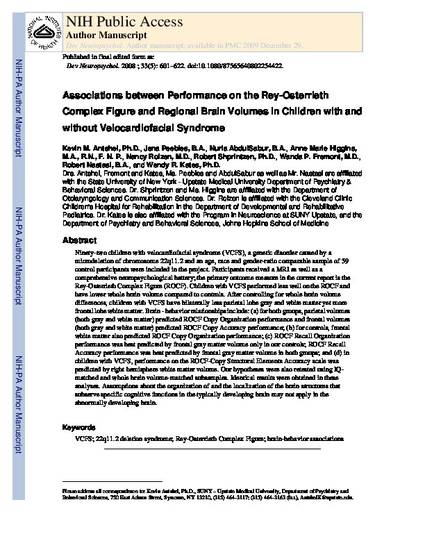
Ninety-two children with velocardiofacial syndrome (VCFS), a genetic disorder caused by a microdeletion of chromosome 22q11.2 and an age, race, and gender-ratio comparable sample of 59 control participants were included in the project. Participants received an MRI as well as a comprehensive neuropsychological battery; the primary outcome measure in the current report is the Rey-Osterrieth Complex Figure (ROCF). Children with VCFS performed less well on the ROCF and have lower whole brain volume compared to controls. After controlling for whole brain volume differences, children with VCFS have bilaterally less parietal lobe gray and white matter yet more frontal lobe white matter. Brain-behavior relationships include: (a) for both groups, parietal volumes (both gray and white matter) predicted ROCF Copy Organization performance and frontal volumes (both gray and white matter) predicted ROCF Copy Accuracy performance; (b) for controls, frontal white matter also predicted ROCF Copy Organization performance; (c) ROCF Recall Organization performance was best predicted by frontal gray matter volume only in our controls; ROCF Recall Accuracy performance was best predicted by frontal gray matter volume in both groups; and (d) in children with VCFS, performance on the ROCF-Copy Structural Elements Accuracy scale was predicted by right hemisphere white matter volume. Our hypotheses were also retested using IQ-matched and whole brain volume-matched subsamples. Identical results were obtained in these analyses. Assumptions about the organization of and the localization of the brain structures that subserve specific cognitive functions in the typically developing brain may not apply in the abnormally developing brain.

Published: Antshel, Kevin M. et.al. "Associations Between Performance on the Rey-Osterrieth Complex Figure and Regional Brain Volumes in Children with and without Velocardiofacial Syndrome." Developmental Neuropsychology 33.5 (2008): 601-622.
At the time of publication, Robert J. Shprintzen was affiliated with SUNY Upstate Medical University.